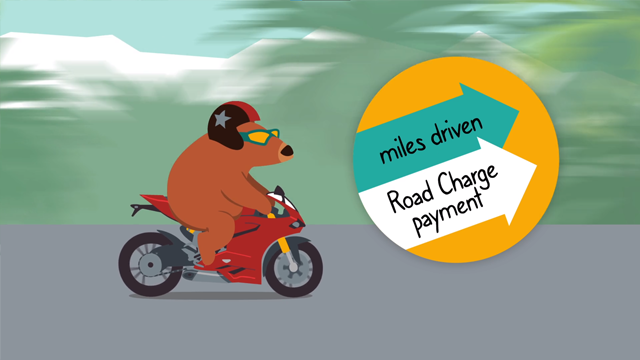FAQs
- Why is there a 2024 Pilot?
-
California passed Senate Bill 339 to test the collection of road charge fees on miles driven in California. Previous road charge pilot tests only simulated payment and those participants did not pay real money to the state. The Legislature now wants to identify risks and challenges with collecting road charges before considering this potential new funding option to maintain roads in California. We need you to participate in the Road Charge Collection Pilot and share your experience.
- How do I participate in the 2024 Pilot?
-
To participate in the 2024 Pilot:
- Sign Up: The Pilot accepted pilot interest sign-ups through June 2024; sign-up period is closed.
- Get Selected: People throughout California will be invited to enroll in the Pilot in July 2024.
- Drive and Pay: Drive and pay road charges for 6 months from August 2024 thru January 2025.
- Pay your road charges each month using a credit or debit card on the Pilot Account website.
- Gas tax credits for your gas used in the Pilot will be refunded at the end of the Pilot.
- Electric vehicles will receive partial credit of their Road Improvement Fee (registration fee).
- Two Surveys: Complete the surveys that will be sent at the beginning and end of the Pilot.
- Get $400: Complete all the required activities for the Pilot to earn up to $400.
- How do I get $400 in the 2024 Pilot?
-
You can earn up to $400* by completing Pilot specific activities:
- $100: Enroll in the Pilot and complete the first survey
- $100: Complete the second survey at the end of the Pilot
- $200: Pay your road charges every month for 6 months
Gift cards will be distributed twice: up to $100 in September 2024, and up to $300 in February 2025. Multiple gift card amounts can be selected with many popular businesses and brands to choose from.
*Elected California officials, and employees of the California State Transportation Agency or any of its agencies or departments, are not eligible to earn up to $400 in gift cards for participating in the Pilot.
- How do I report my miles in the 2024 Pilot?
-
Select one of the following options when you enroll in the Pilot:
- Plug-in Device: A device will be shipped to your home with instructions on how to plug it into your vehicle’s OBD-II port, typically located under the steering wheel. If you choose to use GPS location data, then this option will report any miles driven out of state, on private roads, or on tribal roads. Such miles will not be charged towards your monthly Road Charge. If you do not choose GPS location data, then all miles will be charged as California public roads.
- Vehicle Telematics: This option is available for newer vehicles that have a connected vehicle account through the auto manufacturer. If you don’t currently have an account on your vehicle, you may be able to contact the brand and activate their service. GPS location data may not be available with this option and all miles driven will be charged as California public roads.
- Odometer Entry: Participants who choose this option will upload a photo of the vehicle odometer once a month. All miles driven are charged as California public roads.
- Do I need to pay the Road Charge each month in the 2024 Pilot?
-
Yes, you will be billed for road charges each month based on the miles you drive. The SB 339 legislation requires that participants are randomly assigned to two rate groups, either:
- Fixed rate per mile – all participants in this group will pay the same rate of approximately three cents per mile.
- Individualized rate per mile – all participants in this group will pay a per-mile rate that is based on the state per-gallon fuel excise tax divided by their vehicle’s miles per gallon fuel economy (combined EPA rating).
Use the road charge rate calculator to get estimates for your vehicle. Try the road charge rate calculator now.
The state does not want participants to pay twice for transportation funding, so as road charges are paid there will be gas tax credits accumulated and refunded at the end of the Pilot. Electric vehicles will receive a partial credit of the Road Improvement Fee (annual registration fee).
Participants can also earn up to $400 in gift cards for completing Pilot activities.
- Who do I contact if I have questions about the 2024 Pilot?
-
General questions about the Pilot:
Email us at info@caroadcharge.com.
Call us at (916) 619-6283 toll-free.
- How is transportation funded now?
-
A funding system first approved in 1923
On average, Californians pay about $300 a year in state gas taxes that are charged at the pump when a driver buys gas. This money helps keep both local roads and state highways in good repair. Other state fees also fund transportation, and some counties also charge a local sales tax to further invest in road and transit needs.
Learn more about transportation funding - What is a road charge?
-
Replacing California's gas tax
Road Charge is an alternative funding mechanism that allows drivers to support road and highway maintenance based on how many miles they drive, instead of how many gallons of gas they use. Just like you pay your gas and electric bills based on how much of these utilities you use, a road charge - also called a mileage-based user fee - is a fair and sustainable way to fund road maintenance, preservation, and improvements for all Californians. Instead of paying the state’s gas tax, which disproportionately impacts those who cannot afford more fuel-efficient vehicles, everyone would pay a per-mile fee for how much they use the road, regardless of what kind of car they drive.
Learn more about road charge - Why is California studying road charge?
-
A more sustainable way to fund our roads
As Californians switch to more fuel-efficient vehicles, they buy less gas and pay less gas tax. This means less and less funding to maintain our transportation system. California is leading the way on developing new and innovative ways to move around the state; we need a modern transportation funding system to replace the gas tax that can adapt to and keep up with our state’s changing needs.
Learn more about California's projects - Why not just continue to raise the gas tax?
-
California needs a modern transportation funding system
California leads the nation when it comes to driving more fuel-efficient and zero-emission cars. That’s a good thing! However, because these cars consume less or no gas at all, funding highway and road repairs based on a gas tax no longer works. Even if we keep increasing the gas tax, with fewer Californians buying gas the funding will eventually disappear. California needs to replace the gas tax with a funding system that supports our state’s transportation future.
Learn more about California’s gas tax history - What is the estimated relative cost per household of a road charge versus a gas tax?
-
Previous studies have shown that on average, most driving households – including urban/rural and low/high income households – would not see a significant change in how much they pay if California were to change from a gas tax to a road charge system.
However, there will be a more significant change for drivers of zero-emission vehicles who currently contribute very little money to highway and road repairs because they consume very little gas. The amount of the increase will depend on how much they drive, but these incremental ongoing costs are not expected to change driving behavior or car purchasing decisions.
Additionally, if the state’s roads and highways were kept in better condition, it would lead to a decrease in costs for vehicle repairs. Research estimates that Californians spend an average of $840 annually on vehicle repair costs due to poorly maintained roads.
- How would road charge impact lower income families and/or rural households?
-
Supporting equity is a critical goal for the state and for the road charge program in particular. The current system for funding highway and road repairs based on the gas tax means that, all else equal, people who own less fuel-efficient vehicles pay more because they burn more fuel. Since research shows that rural and low-income households tend to own vehicles with lower fuel efficiency, this means they pay more per mile driven than wealthier and urban households. Road charge is designed to fix this inequity so that everyone pays the same amount per mile driven.
- How would road charge impact Californians who drive electric and other fuel-efficient vehicles?
-
Right now, people who drive electric and other fuel-efficient cars contribute less money for road and highway repairs than people who drive less fuel-efficient cars, even though all vehicles cause wear and tear to California’s roadways and contribute to road congestion. The purpose of road charge is to ensure that everyone pays their fair share for road maintenance based on how much they drive, not the kind of car they own.
Importantly, this change in incremental ongoing costs is not expected to change car purchasing decisions, which research shows are highly influenced by federal and state subsidies and special access to carpool lanes. So it won’t impact California’s ability to achieve our zero-emission vehicle and greenhouse gas reduction goals.
- When is California going to enact road charge?
-
In an effort to ensure California’s transportation funding system can keep up with changing technology and modes of transportation, in 2014, the California State Legislature passed SB 1077 (DeSaulnier) to study road charge as one potential option. As part of the state’s study, the California’s Road Charge Pilot Program launched on July 1, 2016 and ran for nine months to test the possibility of funding road and highway repairs based on how many miles a driver travels instead of how much gas they purchase.
Since then, the state has continued collaboration with its partners and with other states to design, develop, and demonstrate a road charge program that will sustainably support California’s transportation repair and maintenance needs now and in the future. No decisions have been made yet about how, when, or whether to implement road charge – or any other new transportation funding model.
Share your thoughts on what a road charge program might look like
- What is happening at the national level regarding road charge?
-
Congress passed the $1.2 Trillion Bipartisan Infrastructure Bill (BIL) in 2021 that included the first ever National Pilot and extended funding to the states through the Strategic Innovation for Revenue Collection program.
The National Pilot
The BIL calls for spending $50 million over five years on a national pilot to test and demonstrate technology for collecting a motor vehicle per-mile user fee. Many details are still being discussed.
The Strategic Innovation for Revenue Collection Program
The BIL establishes the Strategic Innovation for Revenue Collection program to provide discretionary grants to test the feasibility of a road usage fee and other user-based alternative revenue mechanisms to help maintain the long-term solvency of the Highway Trust Fund. The US Department of Transportation Federal Highway Administration (FHWA) implemented a similar predecessor program, the Surface Transportation System Funding Alternatives (STSFA) Program for the last several years, with a five-year $95 million competitive grant program. California successfully applied for five years of funding through STSFA grant program.




